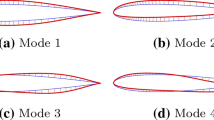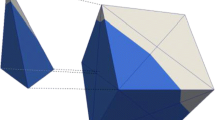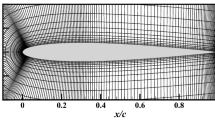Abstract
In this work, a simple and efficient numerical approach to determine the shape of the minimum-drag axisymmetric forebody in inviscid supersonic flow with an attached shock constraint has been described. Taylor–Maccoll equation in conjunction with the tangent cone method is employed to estimate the pressure drag coefficient which is also chosen as the cost function. The forebody geometry is parameterized using a Non-Uniform Rational B-Splines (NURBS) curve whose control points are the design variables for optimisation using the steepest descent algorithm. Numerical studies demonstrate that the optimal forebody geometry for a given length and base radius has as much as 15 % lesser drag, depending on the Mach number than a cone of the same fineness ratio and that the convergence to the optimal solution exhibits a relatively weak Mach-number dependence.



Similar content being viewed by others
Notes
The CPU time was obtained on a dual-core AMD Phenom II machine using the clock_gettime() function which has a resolution of nanoseconds
References
D.N. Srinath, S. Mittal, A stabilized finite element method for shape optimization in low Reynolds number flows. Int. J. Numer Methods Fluids 54, 1451–1471 (2007)
A. Jameson, L. Martinelli, S. Cliff, Aerodynamic shape optimization of transonic and supersonic aircraft configurations. 43rd AIAA aerospace sciences meeting and exhibit, Reno (2005)
J.E. Theisinger, R.D. Braun, Multi-objective hypersonic entry aeroshell optimisation. J. Spacecr. Rockets 46(5), 957–966 (2009)
H. Ogawa, Y. Alazet, R.R. Boyce, A. Isaacs, and T. Ray, Design Optimisation of Axisymmetric Scramjets for Access-To-Space, Proceedings of 9th Australian space science conference, Sydney (2009)
H. Ogawa, R.R. Boyce, A. Isaacs, T. Ray, Multi-objective design optimisation on inlet and combustor for axisymmetric scramjets. Open Thermodyn. J. 4, 86–91 (2010)
K. Tanimizu, D.J. Mee, R.J. Stalker, P.A. Jacobs, Nozzle design study for a quasi-axisymmetric scramjet powered vehicle at Mach 7.9 flight condition. Shock Waves 23, 453–460 (2013)
Th. von Kármán, in The Problem of Resistance in Compressible Fluids. GALCIT Pub.No. 75 (1936)
W.R. Sears, On projectiles of minimum wave drag. Quart. App. Math., IV(4), pp. 361–366 (1947)
A.J. Eggers, M.M. Resnikoff, D.H. Dennis, Bodies of Revolution Having Minimum Drag at High Supersonic Airspeeds. NACA TR-1306 (1957)
W.I. Oehman, S.A. Wallace, Bodies of Revolution Having Minimum Total Drag in Hypersonic Flow. NACA TN D-5438 (1969)
J.D. Anderson, Modern Compressible Flow: With Historical Perspective (McGraw-Hill, New York, 1990)
L.A. Piegl, W. Tiller, The NURBS Book, 2nd edn. (Springer, Berlin, 1996)
N.R. Deepak, T. Ray, R.R. Boyce, Evolutionary algorithm shape optimization of a hypersonic flight experiment nose cone. J. Spacecr. Rockets 45(3), 428–437 (2008)
X. Wang, Method of steepest descent and its applications. IEEE Microw. Wirel. Compon. Lett. 12, 24–26 (2008)
N. Sahoo, Boundary-layer Transition Experiment in a Supersonic Flow. Research Report No.1, Department of Science and Technology, India (2008)
Acknowledgments
The authors would like to thank Schlumberger Asia, for their guidance in carrying out this work.
Author information
Authors and Affiliations
Corresponding author
Rights and permissions
About this article
Cite this article
Natarajan, G., Sahoo, N. & Kulkarni, V. Optimal Forebody Shape for Minimum Drag in Supersonic Flow. J. Inst. Eng. India Ser. C 96, 5–11 (2015). https://doi.org/10.1007/s40032-014-0134-0
Received:
Accepted:
Published:
Issue Date:
DOI: https://doi.org/10.1007/s40032-014-0134-0




